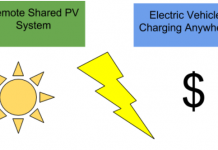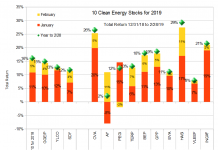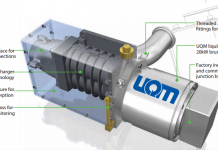Should reduced liquidity at New Flyer Industries concern investors?
New Flyer Industries (NFI-UN.TO, NFYIF.PK) is one of my largest single clean energy investments.  The company describes itself as the "leader in the heavy-duty bus market for the US and Canada." This is why I first brought it to the attention of readers in April 2008, as a company likely to benefit from peak oil. Increasing the fuel efficiency of our vehicle fleet can reduce our consumption of oil in North America, but not at a pace sufficient to both accommodate declining oil supplies and increasing oil demand from the developing world.
The company describes itself as the "leader in the heavy-duty bus market for the US and Canada." This is why I first brought it to the attention of readers in April 2008, as a company likely to benefit from peak oil. Increasing the fuel efficiency of our vehicle fleet can reduce our consumption of oil in North America, but not at a pace sufficient to both accommodate declining oil supplies and increasing oil demand from the developing world.
United States net imports are likely to decline much more quickly than world oil supply. Furthermore, while converting some of our transportation fuel to natural gas or electricity may offset some of these lost imports, both require turnover in the vehicle fleet, and battery electric vehicles and plug-in hybrid vehicles are likely to be too expensive and too limited by available battery manufacturing to make a large enough difference in oil consumption to offset the lost imports. Biofuels (both advanced and conventional) are similarly limited by available able feedstock.
If improvements in the automotive fleet and fuels will come too slowly to offset import declines, we’ll have to look beyond the automobile for fuel savings. If we drive less, we’ll either have to travel less, or shift to other modes of transport. The best solution would be to travel less, and live closer to where we work. Such changes are likely to happen only slowly. Having recently massively "invested" in the suburban project, America is unlikely to retreat quickly from those investments. Ever hopeful, exurban homeowners will cling on, despite rising and volatile gas prices, waiting for the market to "come back" to a place it never should have been in the first place. Even those exurbanites who chose to shift to a more urban, fuel-efficient, lifestyle will sell their houses to others who believe they are getting a great deal, if only because the price has be reduced by 20%. Gas prices are likely to cause suburban home prices to fall faster than urban ones, but it will be longer before most of those suburban homes are unoccupied.
Transit Busses
Both a trend towards urbanization, and unaffordable suburban commutes should favor bus transit. While rail transit is more efficient and more pleasant, it takes years to build out rail transit. Bus transit only requires the purchase of busses, and perhaps some repainting of roads and other minor changes to improve bus speed by giving them preferential right-of way. And because, as Winston Churchill said, "Americans can be counted on to do the right thing… after they have exhausted all other possibilities," we’re not doing nearly enough to prepare for rapidly decreasing oil imports today. Instead, we’re going to be engaging in an after-the-fact, jerry-rigged effort to keep our society functioning when the gasoline lifeblood it depends on suddenly costs several times what we can afford.
In other words, rather than smooth rail transit, most Americans will make due with jerky busses from suburban park-and-rides. If we’re lucky, the busses will be hybrid electric, because if you’ve ever ridden on one, you’ll know that both acceleration and deceleration is much smoother.
Most bus manufacturers are part of larger truck or automotive manufacturers (Scania, Freightliner, DaimlerChrysler) or are privately held (Gillig, Blue Bird, North American Bus Industries, Nova Bus.) New Flyer is an exception, being both publicly traded, and focused on just busses. They have a wide range of products, including compressed and liquid natural gas busses, as well as hybrid and electric trolley busses.
Then and Now
I purchased about half of my current holdings of New Flyer in Spring of 2008, mostly around US$11, and doubled my position in December in the low US$5 range, for an average cost basis of US$8.34, right around current prices. Since the company pays a large combined dividend/interest payment, I’ve been happy with my overall results (The 2008 annual payment was C$1.17, 1/3 of which was qualified dividends and 2/3 of which was interest.) Investors who bought the company when I recommended it as one of my Ten Clean Energy Stocks for 2009 at anywhere near the US$6.60 it was trading at when I wrote the article should be quite pleased as well.
New Flyer’s structure is unusual, with cash flows and payments to holders of "Income Deposit Securities" or IDSs. Each IDSs is composed of a common share of New Flyer Industries, Inc., an Ontario Corporation, and C$5.53 principal amount of subordinated notes of "NFI ULC" an Alberta unlimited liability corporation.
A reader left a comment on my original article expressing concern about the unlimited liability of the ULC. It’s important to note that the IDS holders are not shareholders of the ULC, but rather holders of subordinated notes of the ULC, i.e. debt, not stock. Investors in the IDS (i.e. NFI-UN.TO or NFYIF.PK) should not be subject to any claims beyond their C$5.53 per IDS share NFI ULC subordinated note. IDS investors have an ownership stake in NFI ULC only indirectly through New Flyer Industries, and hence are not exposed to unlimited liability from NFI ULC because New Flyer Industries is a limited liability corporation.
Working Capital
What investors might be concerned about is the deterioration of the cash position of the companies. In the 2008 annual report, the company reported a "customer specific engineering design issue during 2008 Q4 which result
ed in delayed bus completions and deliveries creating a temporary swelling of year-end inventory levels." The Management Discussion and Analysis went on to say "these engineering deficiencies have been resolved and management expects the contract to be substantially delivered during the first half of 2009.
The second quarter 2009 report updates the situation: "As of July 5… 73 of the total 225 equivalent units related to this customer’s contracts had been delivered." 73 of 225 does not sound like "substantially delivered" to me, but the problem does seem to have been mostly resolved to the customer’s satisfaction since the customer has "initiated further option conversions" (i.e. ordered more busses.) Update: This customer is the Chicago Transit Authority (CTA).
However, the delay of deliveries to the CTA, and a smaller delay involving a 30 bus contract with another customer have swollen New Flyer’s inventory and caused NFI ULC to draw down its cash reserves and tap its revolving credit line. In the 2008 annual report management attributed an inventory buildup of 70 units to this problem, which corresponds to an estimated $28 million of deferred revenue. At the end of 2007, the company had $25M in cash, while at the end of Q2 2009, it had no cash and a revolving bank debit of $16M, meaning that the company’s cash position deteriorated by $41M. Because of this negative cash balance and covenants on the subordinated debt, NFI ULC has been unable to make dividend payments to New Flyer, and has instead advanced loans to allow New Flyer to continue dividend payments to shareholders. For IDS holders, this amounts to taking money out of one pocket and loaning it to another, a practice which would become worrying if it were to continue for long. Management has determined that this arrangement will need to continue at least though Q3 2009.
One other major hiccup was an order deferral, announced in June from another major US municipal customer. Because the company’s busses are engineered to order, the company cannot simply shift planned production to other customers. The deferral was due to delays in state funding to the customer. The company has laid off 320 workers and will close plants for 2 weeks at the end of the year in response.
Conclusions
Although these problems seem to be the type which the company will be able to work through, is now working with less than its usual buffer of working capital. Because of the current state of state and municipal budgets, it would not be too surprising to see another order deferral like the recent one. If that were to happen, the company most likely could not continue the current sleight of hand which allows it to continue paying dividends to shareholders, and payments on IDSs would probably be reduced by 1/3 to just the interest on the subordinated notes.
If that were to happen, IDS holders could expect a sharp decline in IDS share prices, as income investors fled the company. Depending on the particular circumstances, that would most likely be an excellent buying opportunity.
With the increase in funding from the ARRA stimulus available over the next year and a half just starting to be distributed, I don’t expect any such hiccups to threaten New Flyer’s long term survival. Still, such hiccups could impact short term profitability due to the company’s inability to substitute new orders for orders which are unexpectedly deferred. Note that the company does not expect any such deferrals, nor do they expect a drop in EBITDA, or to have to reduce IDS payments.
In other words, any such hiccup would be unexpected (by management, at least.) Investors should realize that it is a possibility, and only hold the securities if they consider the potential for appreciation and a hefty income stream to be worth the risk. On the other hand, if business proceeds as management expects, we can expect price appreciation relative to the market as production continues to increase and inventory falls strengthening both revenues and the company’s cash buffer. The liquidity issues should be watched, but should not yet be a cause of deep concern.
I consider New Flyer a stable company in an extremely attractive industry. We can already see some benefits to the company from greater awareness of oil price risks: the company’s product mix has been shifting to include a greater proportion of hybrid busses. The better product mix has allowed them to expand revenues despite the setbacks. Furthermore, the current combined interest and dividend yield of over 13% continues to compensate well for the risk of any price fluctuations. If the payments were reduced to just the payment on the subordinated note, it would still be well over 8%. Meanwhile, the potential for appreciation goes hand in hand with potential increases in the price of oil.
DISCLOSURE: Tom Konrad and/or his clients own NFYIF.
DISCLAIMER: The information and trades provided here and in the comments are for informational purposes only and are not a solicitation to buy or sell any of these securities. Investing involves substantial risk and you should evaluate your own risk levels before you make any investment. Past results are not an indication of future performance. Please take the time to read the full disclaimer here.










Thanks for the analysis Tom.
Given that 2/3 of the cash yield comes from the debt side of the IDS, isn’t there a bit of interest rate risk with NFI.UN?
Should interest rates rise – perhaps substantially if inflation takes hold – how would the IDS’ price behave? Intuitively, it should go down so that the yield is maintained.
If the equity side of the IDS begins to account for more of the total value of the unit, I could see this risk receding (relatively speaking), but currently the debt side represents >50% of total value (C$5.53).
Should operational issues normalize but interest rates rise in early 2010, I could see the latter placing a bit of downward pressure on the stock.
I don’t know if we’re going to have inflation or deflation or both in different sectors. The IDS payments are denominated in CDN$, so it is presumably CDN inflation that you’re worried about. This is a lot less likely than US$ inflation, since the loonie is a petro-currency.
I’m not really sure what the effects of US inflation would be on NFI, but they often speak of the payments being in CDN$ as a “natural hedge” in filings, for what that’s worth.